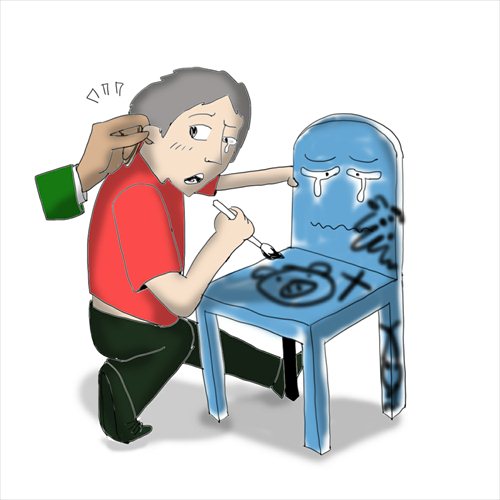Why Shanghai lacks Western-style vandalism

Illustration: Lu ting/GT
Last week the Global Times Metro Shanghai edition printed an informative photo essay on Chinese graffiti, in which it was explained that most of the writing on the wall in China are advertisements for services and products rather than the street art or wanton vandalism seen in Western cities.
The Vandals were a 5th-century tribe that famously sacked Rome and defaced statues and historic works of art along the way. Hence, "vandalism" - the word and the concept - was born. Today, physical destruction of public property is a major problem in the West. Megalopolises like New York City and Los Angeles spend millions of dollars every year just to replace broken benches and windows, fix bus shelters, re-paint walls and scrub train carriages. Nothing is sacred.
While some forms of graffiti are said to have artistic merit and cultural worth or regarded as a form of social protest, more likely the vandalism seen in the West is just an outlet for angry youth and disenfranchised young adults.
Many cities in the US and UK have banned teens from being able to buy spray paint or permanent ink, and more surveillance cameras are being installed in public venues. Nonetheless, vandalism is nearly impossible to detect until it's too late. When the sun rises every morning, urban residents of the West often find their walls and windows freshly painted with obscenities, their parks and gardens wrecked and even their monuments and cemeteries desecrated or overturned.
Meanwhile, here in Shanghai, home to 24 million people, public vandalism is the least of our problems. All across the city, for instance, are bus shelters with huge flat-screen televisions for commuters to watch during their wait. These installations would have been smashed or stolen within their first night in New York or London, and yet here they have stayed untouched and intact since being installed.
The absence of vandalism is a very appealing aspect of life here in Shanghai. But the idea that someone would purposely destroy something that is meant to benefit society is so perplexing to the Chinese that it's almost impossible to explain to them how and why vandalism is such a major problem in the urban West.
In Shanghai, if anyone is caught vandalizing public property they will be forced by authorities to clean it up themselves. Otherwise they will be billed for the expense and also fined up to 500 yuan. In contrast, US fines vary from state to state but can reach up to $25,000 as well as imprisonment. This figure illustrates the severity of the problem there compared with here.
There have, of course, been many high-profile instances of vandalism in China. The worst in history was probably the sacking of Beijing's Forbidden City and the Summer Palace in 1900, where soldiers from an eight-nation force led by Britain looted precious artifacts and treasures. The Cultural Revolution (1966-76) also saw many historic works, books and art, and even entire temples, burned in public pyres by Red Guard youth.
But today, vandalism perpetrated by the Chinese is so rare that when it does happen it makes national headlines. Netizens were enraged in 2013 when a Nanjing teenager on a trip to Egypt scratched his name on a 3000-year-old relief at the Temple of Luxor. The words "Ding Jinhao was here" caused such a stir that the boy was quickly human fleshed searched by his Chinese compatriots and publicly exposed.
Another difference between China and the West when it comes to graffiti is that in major Chinese cities the local governments have constructed "art zones" specifically for the purpose of letting street-artists decorate public walls with spray paint murals. Beijing's colorful 798 art district was the first to start this trend, followed by Shanghai's M50 and Guangzhou's Redtory. With these government-sanctioned urban canvasses, Chinese street artists emulating their Western counterparts need not risk fines or ostracism.
Whether the Chinese have a deeper respect for communal property or if they simply lack the outrage of Western teens is up for debate among sociologists and Sinologists. But either way, Chinese and foreign residents in Shanghai can agree that for all of our developing city's growing pains and social issues, it's nice to at least not have to worry about people purposely breaking stuff.
The opinions expressed in this article are the author's own and do not necessarily reflect the views of the Global Times.